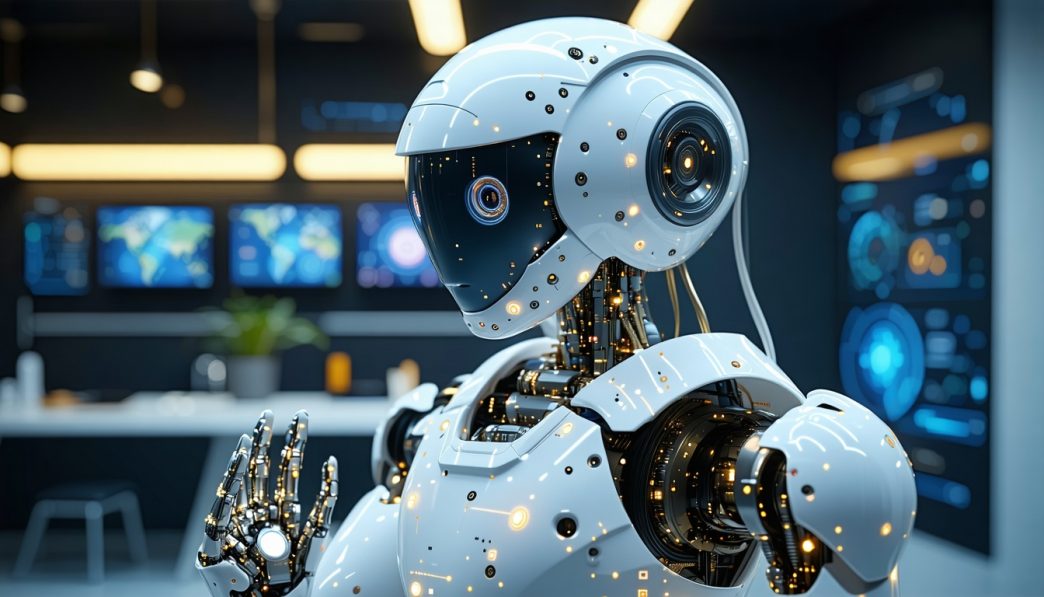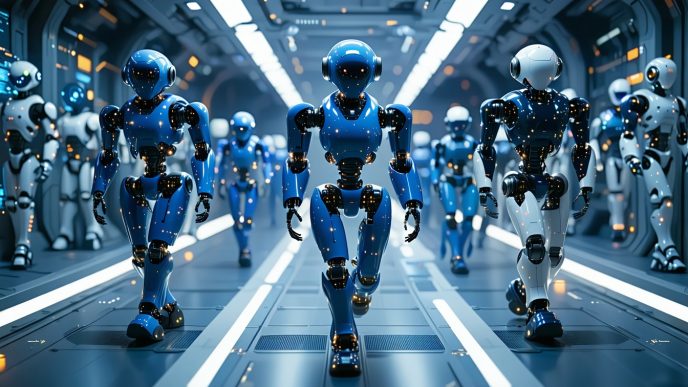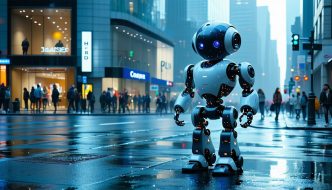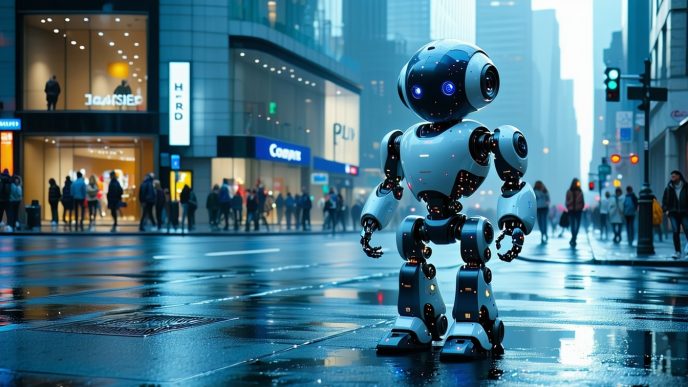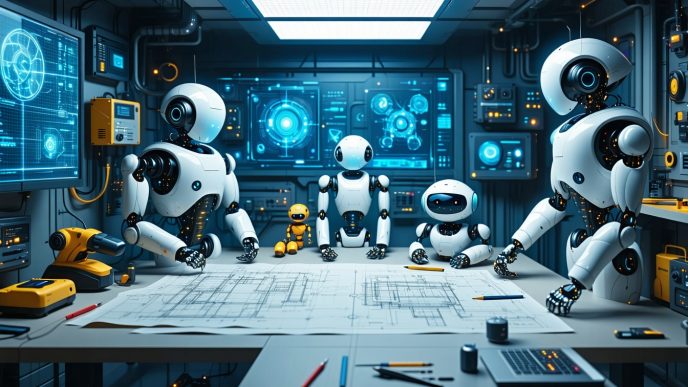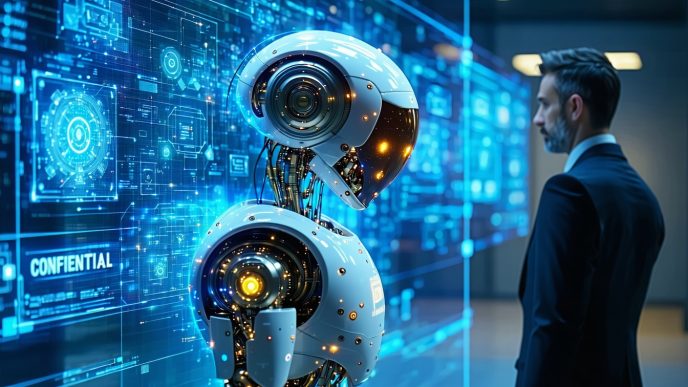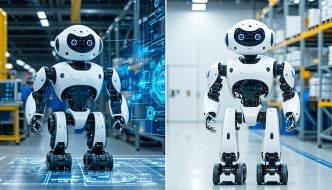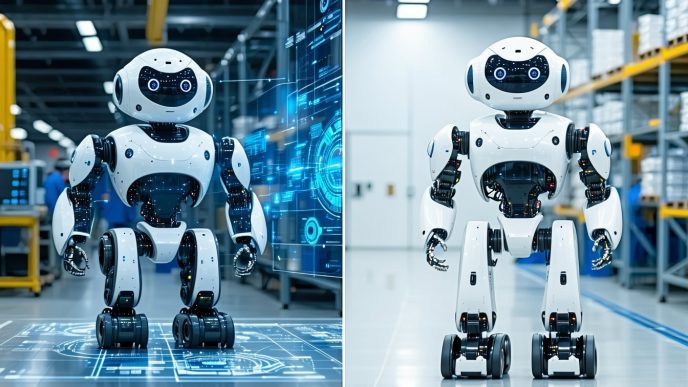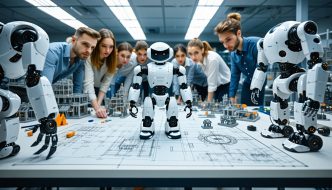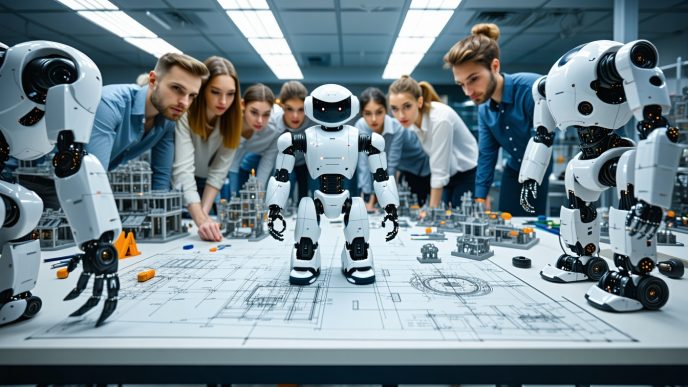Introduction to Humanoid Robots
Humanoid robots are designed to emulate human appearance and behavior, playing an essential role in various applications from companionship to assistive technologies. Their development has been driven by advancements in robotics, artificial intelligence, and sensor technology, leading to more capable and versatile machines.
The Evolution of Humanoid Robots
The journey of humanoid robots began in the mid-20th century with simple mechanical figures. Over the decades, innovations in materials, computing power, and algorithms have transformed these early prototypes into sophisticated machines. Today’s humanoid robots exhibit remarkable dexterity and interaction capabilities, closely mimicking human movements and behaviors.
The following table summarizes key milestones in the evolution of humanoid robots:
| Year | Development | Notable Robot |
|---|---|---|
| 1956 | First humanoid robot prototype | Unimate |
| 1997 | Introduction of conversational bots | Robi |
| 2000s | Enhancements in mobility | ASIMO |
| 2010s | Advancements in AI and sensors | Sophia, Tesla Optimus |
Importance of Sensors in Humanoid Robots
Sensors are pivotal in enabling humanoid robots to perceive their environment, make decisions, and interact with humans. The integration of various types of sensors allows these robots to gather information about their surroundings, which is crucial for tasks like navigation and social interaction.
Humanoid robot sensors help achieve:
-
Vision: Cameras and depth sensors provide the ability to “see,” allowing robots to recognize objects and navigate spaces. More on these technologies can be found in the section on vision sensors.
-
Balance: Devices such as accelerometers and gyroscopes maintain stability and orientation. Balance sensors are essential for movement and safety.
-
Touch: Touch sensors enable robots to feel pressure and texture, enhancing their interaction capabilities. This tactile feedback is critical for tasks requiring precision.
The effective functioning of humanoid robots depends significantly on the quality and integration of these sensors. With ongoing advancements in sensor technology, humanoid robots are poised to become increasingly responsive and versatile in various applications, including humanoid robots for home use and humanoid robots in healthcare.
Vision Sensors
Vision sensors play a crucial role in enhancing the capabilities of humanoid robots, providing them with the ability to perceive and interact with their environment. The main types of vision sensors utilized in humanoid robots include cameras and depth sensors.
Cameras
Cameras are the most common vision sensors found in humanoid robots. They capture visual information, allowing the robots to recognize objects, respond to visual cues, and navigate their surroundings. Cameras can operate in various modes, including standard visible light, infrared, and low-light conditions.
The specifications for cameras in humanoid robots often vary based on the intended application. Below is a table summarizing common camera specifications:
| Specification | Description |
|---|---|
| Resolution | 720p to 4K HD |
| Frame Rate | 30 to 60 frames per second |
| Lens Type | Fixed or adjustable |
| Field of View | 60° to 120° |
| Low-Light Capability | Yes or No |
With the ability to capture real-time images and videos, cameras help enhance functionalities such as face recognition and object tracking. For more on how humanoid robots navigate their environment, see our article on humanoid robot navigation.
Depth Sensors
Depth sensors provide additional information that cameras alone cannot. They measure the distance between the sensor and objects in the environment, creating a three-dimensional representation. This capability is essential for tasks such as obstacle avoidance and spatial awareness.
Depth sensors can utilize several technologies, including:
- Stereo vision
- Time-of-flight (ToF)
- Structured light
The following table outlines common specifications for depth sensors used in humanoid robots:
| Specification | Description |
|---|---|
| Range | 0.2 m to 10 m |
| Depth Resolution | 1 cm to 5 cm |
| Field of View | 70° to 120° |
| Sampling Rate | 30 to 60 Hz |
By integrating data from depth sensors, humanoid robots can effectively analyze their surroundings and carry out complex tasks. For more on how humanoid robots utilize sensory data, refer to our article on humanoid robot sensors.
Combining information from both cameras and depth sensors enhances the overall perception capabilities of humanoid robots, allowing them to function more effectively in various settings.
Balance Sensors
To maintain stability and navigate their environment effectively, humanoid robots rely on a range of balance sensors. These sensors help robots assess their position and movement, ensuring that they perform tasks safely and efficiently. Key balance sensors include accelerometers, gyroscopes, and inertial measurement units (IMUs).
Accelerometers
Accelerometers are sensors that measure acceleration forces acting on the robot. They detect changes in velocity and orientation, providing critical data for balance control. By measuring linear acceleration along one or multiple axes, accelerometers help humanoid robots understand their orientation in space.
| Specification | Value |
|---|---|
| Axes of Measurement | 1, 2, or 3 |
| Range of Measurement | ±2g to ±16g |
| Typical Applications | Motion detection, tilting measurement |
Gyroscopes
Gyroscopes are sensors that measure the rate of rotation. They provide information about the robot’s angular velocity, allowing for precise control of movement. By combining data from gyroscopes with accelerometer readings, humanoid robots can maintain balance even while in motion.
| Specification | Value |
|---|---|
| Axes of Measurement | 1, 2, or 3 |
| Range of Measurement | ±250°/s to ±2000°/s |
| Typical Applications | Balancing, stabilization, navigation |
Inertial Measurement Units (IMUs)
Inertial Measurement Units (IMUs) combine accelerometers and gyroscopes to offer comprehensive motion sensing. IMUs provide critical data for calculating the robot’s position, orientation, and velocity. This integration allows for enhanced stability and control during various tasks, making IMUs a vital component in humanoid robots.
| Specification | Value |
|---|---|
| Axes of Measurement | 6 (3 accelerometers, 3 gyroscopes) |
| Output Frequency | Up to 1000 Hz |
| Typical Applications | Navigation, robotics, mobile devices |
The balance sensors mentioned above are essential to the functionality of humanoid robots, enabling them to perform tasks such as walking, turning, and interacting with the environment. A combination of accelerometers, gyroscopes, and IMUs allows these robots to adapt to their surroundings effectively, contributing to their overall capabilities. For more information on how humanoid robots navigate their environments, read about humanoid robot navigation.
Touch Sensors
Touch sensors are an essential component in the functioning of humanoid robots, providing them with the ability to interact with their environment through tactile feedback. This section will explore three main types of touch sensors used in humanoid robots: pressure sensors, tactile sensors, and force sensors.
Pressure Sensors
Pressure sensors are designed to detect the force of contact with an object. They play a crucial role in enabling humanoid robots to perform delicate tasks, such as holding or manipulating objects without causing damage.
These sensors can be categorized based on their sensitivity and technology utilized. Common types of pressure sensors include:
| Sensor Type | Sensitivity Range (kPa) | Applications |
|---|---|---|
| Capacitive | 0.01 – 100 | General-purpose applications |
| Piezoelectric | 0.1 – 500 | Vibration detection and impact monitoring |
| Resistive | 1 – 200 | Touch-sensitive buttons and interfaces |
Tactile Sensors
Tactile sensors mimic the human sense of touch by detecting surface properties and texture. These sensors enable humanoid robots to identify differences in materials and to understand whether surfaces are smooth or rough.
The functionality of tactile sensors can be arranged in various configurations, such as:
| Sensor Type | Operational Mechanism | Key Features |
|---|---|---|
| Optical Tactile | Light reflection change | High-resolution texture detection |
| Piezoelectric Tactile | Pressure-induced electric signal | Good for dynamic touch response |
| Mechanoreceptor-based | Physical deformation | Mimics human skin response |
Force Sensors
Force sensors measure the amount of force exerted by or on an object, providing important feedback for control systems in humanoid robots. These sensors ensure that the robot exerts the appropriate amount of force during interactions, preventing potential damage to the objects being handled.
Force sensors are often used in robotic applications where precise control of grip strength is necessary, including:
| Sensor Type | Force Sensing Range (N) | Typical Uses |
|---|---|---|
| Strain Gauge | 0.1 – 1000 | Robotics, automotive applications |
| Load Cells | 0.5 – 5000 | Weighing systems, industrial robots |
| Torque Sensors | 0.1 – 300 | Robotics requiring twisting or turning |
The integration of pressure, tactile, and force sensors enables humanoid robots to interact intelligently with their surroundings. Exploring these sensor types is vital for understanding the capabilities of humanoid robot sensors and how they enhance robotic performance. For more information on humanoid robotics, check out articles related to humanoid robots for home use or humanoid robots in healthcare.
Integration of Sensors
The integration of sensors is a crucial aspect of enhancing the capabilities of humanoid robots. By allowing various types of sensors to work together, these robots can achieve a more sophisticated level of interaction with their environment.
Sensor Fusion
Sensor fusion involves combining data from multiple sensors to produce more accurate and reliable information than what each sensor could provide on its own. This approach allows humanoid robots to interpret complex stimuli from their surroundings, leading to improved decision-making and responses.
For instance, vision sensors such as cameras can be integrated with depth sensors to assess distances and create a 3D map of the environment. This integration facilitates better navigation and obstacle avoidance. The following table highlights common sensor types and their integrated benefits:
| Sensor Type | Functionality | Benefits of Integration |
|---|---|---|
| Vision Sensors | Capture visual data | Improved depth perception and spatial awareness |
| Depth Sensors | Measure distance to objects | Enhanced obstacle detection |
| Balance Sensors | Maintain stability and posture | Increased mobility and balance control |
| Touch Sensors | Provide feedback on surface contact | Better interaction with objects and surfaces |
Through sensor fusion, humanoid robots enhance their operational capabilities, allowing them to adapt to dynamic environments and perform tasks more efficiently.
Role in Enhancing Robot Functionality
The integration of various sensors greatly enhances the functionality of humanoid robots. By utilizing data from different sensory inputs, these robots can exhibit more lifelike behaviors and can better assist in diverse applications, from healthcare to companionship.
Key enhancements include:
-
Improved Navigation: By combining data from vision and balance sensors, humanoid robots can navigate complex environments, avoiding obstacles and adjusting their posture as needed. This is particularly crucial for robots operating in settings like homes or healthcare facilities. For further insights into humanoid robots in these environments, visit humanoid robots for home use.
-
Enhanced Interactivity: The integration of touch sensors improves the ability of humanoid robots to engage with humans and objects. This sensory feedback allows robots to perform delicate tasks more effectively, which is vital in scenarios such as caregiving or education.
-
Adaptive Response: Integrated sensors allow humanoid robots to respond to real-time changes in their surroundings. For example, if a robot detects a person approaching, it can adjust its position or orientation accordingly.
Understanding the role of sensor integration and fusion is essential for advancing the field of humanoid robotics. These innovations promise to improve everything from functionality in daily chores to the provision of companionship and assistance in healthcare settings. For more insights into the impacts of humanoid robots, explore our article on humanoid robots in healthcare.
Emerging Sensor Technologies
The development of humanoid robots continues to evolve, driven significantly by advancements in sensor technologies. Among these are advanced vision systems and haptic feedback sensors, which enable robots to interact with their environment in more sophisticated ways.
Advanced Vision Systems
Advanced vision systems utilize a combination of high-resolution cameras, infrared sensors, and sometimes even artificial intelligence algorithms to enhance a robot’s ability to perceive its surroundings. These systems allow humanoid robots to recognize faces, detect objects, and navigate complex environments with remarkable accuracy.
| Feature | Description |
|---|---|
| High-Resolution Cameras | Offer detailed images for object recognition and scene understanding. |
| Infrared Sensors | Help detect heat and improve depth perception, especially in low-light conditions. |
| AI Algorithms | Enable real-time analysis and interpretation of visual data for better decision-making. |
With these capabilities, humanoid robots can perform tasks such as humanoid robot navigation and even engage in social interactions by recognizing and responding to human emotions. Such advanced systems greatly enhance the functionality and versatility of these robots.
Haptic Feedback Sensors
Haptic feedback sensors simulate the sense of touch by providing tactile feedback to humanoid robots. These sensors can detect pressure, vibration, and texture, allowing robots to interact with objects in a more human-like manner.
| Sensor Type | Functionality |
|---|---|
| Pressure Sensors | Measure the force applied to the robot’s surface, enabling it to handle delicate objects without damaging them. |
| Tactile Sensors | Provide information about surface texture, aiding in object manipulation and grip. |
| Force Sensors | Monitor applied forces to prevent slipping and ensure secure handling. |
Haptic feedback sensors play a crucial role in applications involving humanoid robots in healthcare and humanoid robots for companionship. By allowing robots to ‘feel,’ these sensors facilitate more natural interactions amidst humans.
Together, advanced vision systems and haptic feedback sensors represent a significant step forward in the development of humanoid robot sensors, enhancing their ability to function autonomously and perform complex tasks effectively.
Importance of Sensor Calibration
The performance and reliability of humanoid robot sensors are significantly influenced by proper calibration. Calibration ensures that the data collected by the sensors reflects the true conditions in which the robot operates.
Ensuring Accuracy
Accuracy in sensor data is paramount for humanoid robots to function effectively. Without proper calibration, sensors may provide misleading information, leading to suboptimal performance. This can affect various functionalities, such as movement, obstacle avoidance, and object recognition.
Calibrated sensors contribute to:
| Sensor Type | Importance of Calibration |
|---|---|
| Vision Sensors | Accurate image processing and depth perception |
| Balance Sensors | Correct movement and stability assessment |
| Touch Sensors | Reliable feedback for interaction with objects |
If sensors are not properly calibrated, robots may struggle to navigate environments or understand user commands. For more information on how humanoid robots navigate, refer to our article on humanoid robot navigation.
Calibrating Sensor Data
Calibrating sensor data involves adjusting the output to account for known errors or variances. This process can include:
- Zeroing Sensors: Ensuring that a sensor reads zero under known no-input conditions.
- Reference Measurements: Comparing sensor data against standard references to identify discrepancies.
- Regular Updates: Implementing periodic recalibration to maintain sensor accuracy over time.
Common calibration techniques include:
| Technique | Description |
|---|---|
| Offset Calibration | Correcting a known bias in sensor readings |
| Gain Calibration | Adjusting sensor output sensitivity |
| Temperature Compensation | Modifying outputs based on environmental conditions |
Implementing these calibration techniques ensures that sensors consistently deliver reliable data, enhancing the overall functionality and reliability of humanoid robot systems. For insights into the various types of sensors used in humanoid robots, explore our section on humanoid robot sensors.
Future Prospects
Innovations in Sensor Technology
The field of humanoid robots continues to evolve, largely driven by advancements in sensor technology. These innovations are crucial for enhancing the capabilities of humanoid robots, making them more adaptable and versatile in various environments. Some of the recent innovations include:
| Sensor Type | Key Innovations |
|---|---|
| Vision Sensors | Integration of AI for improved object recognition and depth perception |
| Touch Sensors | Development of sensors that mimic human-like sensitivity and feedback |
| Balance Sensors | Use of advanced algorithms for real-time adjustments in posture |
Emerging technologies such as artificial intelligence and machine learning are being incorporated into sensor systems, enabling robots to process sensory information more efficiently. Enhanced vision systems that utilize neural networks can allow robots to interpret visual data similarly to humans. Additionally, haptic feedback sensors are making touch interaction more intuitive, granting humanoid robots the ability to respond to tactile inputs more effectively.
Potential Impact on Humanoid Robots
Innovations in sensor technology will have a significant impact on the functionality and applications of humanoid robots. As these sensors become more sophisticated, several developments are anticipated:
-
Enhanced Interaction: Robots will be able to interact more naturally with humans, responding to both visual and tactile cues for more fluid communication. Increased reliance on voice interfaces in humanoid robots will further facilitate these interactions.
-
Improved Navigation: With better balance and vision sensors, humanoid robots will navigate environments more skillfully. This capability is essential for tasks ranging from humanoid robot navigation in crowded spaces to performing daily chores.
-
Versatile Applications: As sensors improve, humanoid robots will find expanded use in various fields such as healthcare, education, and elder care. Their ability to respond to human emotions and actions will enhance their role in humanoid robots in healthcare and humanoid robots for companionship.
-
Increased Safety: Advanced sensor technologies will lead to better safety systems within robots, minimizing the potential risks associated with human-robot interactions. This improvement is critical for applications in scenarios like humanoid robots for security and humanoid robots in smart homes.
The advancement of sensor technology will fundamentally alter the relationship humans have with robots. As these machines become smarter and more responsive, they will be increasingly integrated into everyday life, ultimately enhancing human experiences across multiple sectors.

